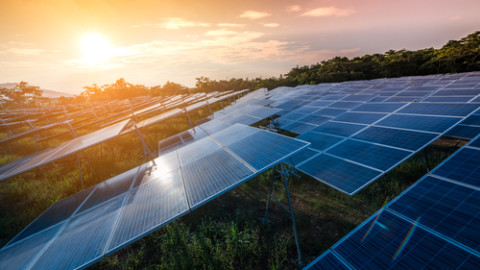Taking on a director role in Australia’s national science agency is certainly not for the faint of heart – or a pessimist. The industry is experiencing rapid change and enduring pressures from not only political and environmental sectors, but also from everyday Australians who want more affordable, reliable and cleaner sources of energy. It would seem new Director of Energy, Dr Dietmar Tourbier, has his work cut out for him.
If destiny had played its cards slightly differently, Dr Dietmar Tourbier could have embarked on a career as an astronaut. With a Master’s Degree in aerospace engineering from the University of Stuttgart and a PhD with a focus on computational fluid dynamics from the University of Arizona under his belt, Dr Tourbier’s first industry job was working on technology development for an aerospace company.
But ten hours spent in a vacuum chamber at NASA’s Johnson Space Centre testing a glove prototype revealed Dr Tourbier’s claustrophobia and cut short his ambitions for space exploration.
“I’m still fascinated with space,” Dr Tourbier said, speaking from his home in Victoria.
“I really appreciate the technology development we gained through space flight. But after that test – that time spent panicking in a small capsule – I knew I was never going to do it again.”
Fueling new passions
A loss for the aerospace sector was a gain for the energy industry. Dr Tourbier moved on to a highly successful 20-year career with General Electric (GE), starting with a role at their solid oxide fuel cell (SOFC) division in California, where he developed a passion for clean energy through fuel cell development.
When GE stopped working on fuel cells in 2007, Dr Tourbier remained with the company but returned to his home country of Germany – first in a leadership position with the global power electronics technology research group, and then as their European Research Leader.
It wasn’t until 2018, when GE started closing all their corporate research centres outside the US, that Dr Tourbier eventually moved to Australia with his family, and took up a position as Director of the Australian Solar Thermal Research Institute (ASTRI) – an eleven year, $110 million international research collaboration led by CSIRO.
“My wife is originally from Arizona, but she had been living in Australia and we had been splitting our time going back and forth between Australia and Germany,” Dr Tourbier explained.
“When GE closed down their international centres, I took that as a sign that it was the right time to move again. My wife discovered this job advert from a place called CSIRO. I assumed that as I was German and it was the Australian national science agency, they would never hire me. But, to cut a long story short – they did!”
Excelling with experience
During his tenure as Director of ASTRI, Dr Tourbier brought together an impressive team of research organisations and engaged industry partners to incorporate solar thermal technologies developed by the institute. While there are not yet any solar thermal plants running in Australia, ASTRI’s research continues to bring the goal of efficient, affordable solar thermal much closer.
Dr Tourbier’s success in this initial role with CSIRO, along with the experience gained through two years as Deputy Director of the Energy Business Unit, meant that he was an obvious candidate when the Director of Energy position became vacant in 2022. His appointment to that role was formally announced in May 2023.
It’s an exciting, but enormously challenging time to step into the role as CSIRO’s Director of Energy. Australia’s energy sector is undergoing a radical transformation – not just in terms of electricity generation, but also across industry, transport and exports. New technologies, changing consumer preferences and ambitious emissions reduction targets are driving the transition at a rapid pace – and while that’s definitely a good news story, it’s also raising some challenges that need to be addressed.
Solving great challenges
As the national science agency, CSIRO is tasked with providing robust, actionable energy research to government, industry and other stakeholders, allowing them to target investments, implement policies, and adopt new technologies over the coming decades.
Steering Australia through the complexities of an energy transition to net zero emissions will require Dr Tourbier to draw on every bit of his deep industry knowledge, his networks of national and international stakeholders, and his passion for innovation and technology.
However, he is keen to emphasise that CSIRO’s strength lies in its breadth of expertise and collaborative approach to research.
“At CSIRO we are working on solving Australia’s greatest challenges that we have identified,” Dr Tourbier said.
“We are addressing those across the whole organisation and taking a multidisciplinary approach. There are six focus areas, which include Health and Wellbeing, Future Industries, Food Security and Quality, Secure Australia and Region, and Resilient and Valuable Environments. I am responsible for the Sustainable Energy and Resources challenge.”
Impactful missions
Within each challenge, there are a number of Missions: large-scale, impact focused scientific and collaborative research initiatives aimed at making significant breakthroughs with a tangible end goal.
“Missions are portfolios that have, by definition, a finite time to deliver impact,” Dr Tourbier explained.
“We have discovered that they help us work much more effectively across different business units. For Sustainable Energy and Resources, the first two Missions we have established are Hydrogen Industry and Towards Net Zero.”
CSIRO’s Hydrogen Industry Mission was established in 2021, with a focus on building commercially-viable Australian hydrogen energy.
Towards Net Zero was established in 2022 with an initial investment of $90 million, with the goal of helping Australia’s regions and hardest to-abate sectors halve their emissions by 2035. There are currently two additional Missions in development that are of particular relevance to the energy sector and will be a major focus for Dr Tourbier over the coming months: Renewable Energy Powerhouse and Smart Energy.
“We have all the ingredients here in Australia for the critical energy minerals that are required to power the clean energy transition,” Dr Tourbier said.
“But at the moment we dig those up, ship them elsewhere, and then have to buy back the products. What we’d like to do with the Renewable Energy Powerhouse Mission is explore how we can move Australia further along the value chain. There’s an International Energy Agency (IEA) analysis that shows Australia can have the lowest cost clean energy of all OECD countries – we want to help achieve that.
“Smart Energy is about how we design a system with far more connectivity between transport, heavy industry, communities and consumers. Where hydrogen, gas, water and electricity are more interlinked than they are today. We’re moving to a far more dynamic energy system, and working out how to operate it is a complex challenge.”
“We need our energy system to be clean,” Dr Tourbier said.
“But we also need it to be sustainable, reliable and affordable, and we need that to happen as quickly as possible. I am excited to play my part in that.”
This sponsored editorial was brought to you by CSIRO.
















